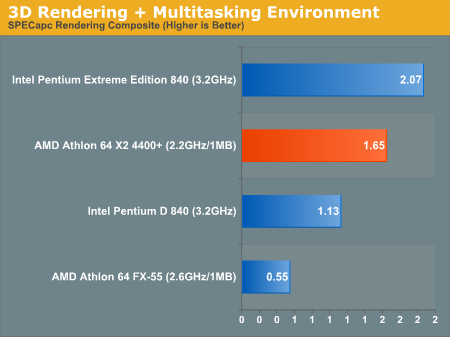AMD's dual core Opteron & Athlon 64 X2 - Server/Desktop Performance Preview
by Anand Lal Shimpi, Jason Clark & Ross Whitehead on April 21, 2005 9:25 AM EST- Posted in
- CPUs
Multitasking Scenario 4: 3D Rendering
We received several requests for a 3D rendering multitasking test, so we put one together. For this test, we ran our SPECapc 3ds max 6 benchmark while we had iTunes, Firefox and Newsleecher all running like we have in previous tests. The application focus remained on Firefox to give it the highest scheduler priority, and the results are below: 
What's also interesting is that the performance of the Athlon 64 X2 4400+ is virtually identical with the Athlon 64 FX-55 from our standalone 3ds max test (1.65 vs 1.66). In this benchmark, the Pentium Extreme Edition 840 takes a pretty significant lead, thanks to HT. We see that even with a dual core CPU, there are still some issues to overcome with the OS' scheduler. So, we get an unusually large increase in performance due to HT due to the scheduler being tricked into sending more threads to the CPU rather than attempting to have them preempt one another for CPU time.










144 Comments
View All Comments
Phlargo - Thursday, April 21, 2005 - link
Sounds like computing could change a lot in the next 6 months.I can't wait to get my hands on a dual core chip - that type of multitasking gaming performance is what I've been waiting for... 92% of unfettered performance during Doom3? That's unbelievable.
manno - Thursday, April 21, 2005 - link
Another thing to consider is that the 939, and 940 Dual Cores work with old mobos. so that saves upgraders ~$100 for the mobo (I have no clue what PD mobo's are going to cost) plus the cost of DDR2 ~$100 for 512MB, not true if you're going with the PD. So if you own a 939 a 2.8 PD will realy cost you ~$441, 3.0 -$516, 3.2 ~$730.Throw that out the window if you're starting from scratch however.
manno - Thursday, April 21, 2005 - link
Great review very detailed, I have one caveat, and I should preface it with the fact that I own 4 systems, and all of them have Athlon 64's or XP's.That being said your "Multitasking Scenario 2: File Compression" Seems to be misleading, and identifies the A64 as the processor of choice in the 2nd portion of the analysis.
Maybe I'm wrong but from what I understand with how the test was performed you archived the file, got the amount of time it took to archive the file "x" for instance, and then figured out how many emails got imported in time "x" now because some processors took longer to create the archive than others they had more time to import emails. so in order to make this data more reflective of the performance of each processor you need to divide the number of emails imported by "x", and get e/s. The modified graph should be
PD 3.2 =19124/5.08 or 3764.57 e/s
A64 X2 =21687/6.25 or 3469.92 e/s
PEE 3.2 =16875/6.65 or 2537.59 e/s
AFX 55 = 3800/5.88 or 646.26 e/s
These corrected numbers show that at least in this test the PD 3.2 is the winner by ~8%
-manno
Calin - Thursday, April 21, 2005 - link
At that prices, most of the users really won't need their current mainboards for new dual core processors. I would prefer to have lower priced single core than that prices on dual core.blckgrffn - Thursday, April 21, 2005 - link
We are talking about by this fall, folks. And a 90nm Dual core still uses LESS die than 2 2800+ put together because it is on a manufacturing smaller process, especially if they stick to a 512k cache which is obviously the sweet spot. By this fall I expect that we will see sub $200 dual cores from Intel to squeeze AMD on the desktop market. What is a real shame is that AMD doesn't have suffcient fabs to handle potential demand.For those of you who got all hot in your pants and said I can't buy a sub $200 dual core Intel right now, it is just as true that I can't buy one it all! ;P Chill!
PeteRoy - Thursday, April 21, 2005 - link
Impressive.josedawg - Thursday, April 21, 2005 - link
Am I mistaken in thinking that AMD was throwing out their desktop dualcore line (A64 X2) in 2006? What prompted their earlier release of them? Was it the demand for desktop dualcore, pressure from Intel stealing desktop dualcore market, or excellent manufacturing at the AMD plants?KeithDust2000 - Thursday, April 21, 2005 - link
blckgrffn, "so if they can't bring anything out under $200 I will probably have to go with Intel. Boo for that ;) "INTEL doesn´t have one under $200 either.
Jeff7181 - Thursday, April 21, 2005 - link
#14... all socket 939 motherboards will support the X2 with a BIOS upgdate.Zebo - Thursday, April 21, 2005 - link
#9 They'd have to release a 1.6 @ $240 to accurately compete with Intels slowness in Pentium D's starting at $241. Sorry not gonna happen. AMD not for budget shoppers anymore but those interested in performance. Want the best? Pay the price. Or substandard CPU at a discount?I can see a 1.8 for about $250 though however no way you're going to get into DC for less than $200.